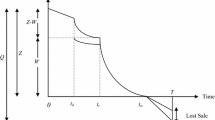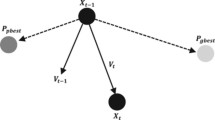Abstract
This paper proposes a method to optimize both the total cost and order fill rates in a supply chain using the particle swarm optimization (PSO) method. This method automatically adjusts the initial inventory levels of all tiers involved in a supply chain by considering information quality level (IQL), which is determined by the degree of availability of lead time history data. Analyses of variance are used to examine if there are any effects of IQL on the total cost and order fill rates. The results show that the proposed method finds better solutions which provide a lower inventory level while maintaining higher order fill rates than when PSO is not applied.
Similar content being viewed by others
References
Zhang C, Zhang C (2007) Design and simulation of demand information sharing in a supply chain. Simul Model Pract Theory 15:32–46
Lee HL, Padmanabhan V, Whang S (1997) Information distortion in the supply chain: the bullwhip effect. Manag Sci 43(4):546–558
Forrester JW (1958) Industrial dynamics—a major breakthrough for decision making. Harv Bus Rev 36(4):37–66
Chatfield DC, Kim JG, Harrison TP, Hayya JC (2004) The bullwhip effect—impact of stochastic lead time, information quality, and information sharing: a simulation study. Prod Oper Manag 13(4):340–353
Park KJ (2010) Effect of initial conditions on the total inventory cost in a supply chain. J Korean Soc Supply Chain Manag 10(1):191–198
Chen F, Drezner Z, Ryan JK, Simchi–Levi D (2000) Quantifying the bullwhip effect in a simple supply chain: the impact of forecasting lead times and information. Manag Sci 46(3):436–443
Kelepouris T, Miliotis P, Pramatari K (2008) The impact of replenishment parameters and information sharing on the bullwhip effect: a computational study. Comput Oper Res 35:3657–3670
Lau RSM, Xie J, Zhao X (2008) Effects of inventory policy on supply chain performance: a simulation study of critical decision parameters. Comput Ind Eng 55:620–633
Lee HL, So KC, Tang CS (2000) The value of information sharing in a two-level supply chain. Manag Sci 46(5):626–643
Warburton RDH, Disney SM (2007) Order and inventory variance amplification: the equivalence of discrete and continuous time analyses. Int J Prod Econ 110:128–137
Zhang X (2004) The impact of forecasting methods on the bullwhip effect. Int J Prod Econ 88:15–27
Park KJ (2009) Effect of customer demand on total inventory cost and order fill rate in a supply chain. J Soc Korea Ind Syst Eng 32(3):93–98
Park KJ (2009) Effect of initial conditions of beer game in a supply chain. The 5th International Congress on Logistics and SCM Systems(ICLS2009), pp. 156–162
Minderhoud S, Fraser S (2005) Shifting paradigms of product development in fast and dynamics markets. Reliab Eng Syst Saf 88:127–135
Strozzi F, Bosch J, Zaldivar JM (2007) Beer game order policy optimization under changing customer demand. Decis Support Syst 42:2153–2163
Thomson JS, Mosekilde E, Sterman JD (1991) Hyperchaotic phenomena in dynamic decision making. Complexity, Chaos, and Biological Evolution, pp. 397–420, New York
Julio EA, Everson RM, Fieldsend, JE (2005) A MOPSO algorithm based exclusively on Pareto dominance concepts. Evol Multi-Criterion Optim pp. 1–15
Mahnam M, Yadollahpour MR, Famil-Dardashti V, Hejazi SR (2009) Supply chain modeling in uncertain environment with bi-objective approach. Comput Ind Eng 56:1535–1544
Mostaghim S, Teich J (2003) Strategies of finding good local guides in multi-objective particle swarm optimization(MOPSO), IEEE 2003 Swarm Intelligence Symposium pp. 26–33
Law AM, Kelton WD (1991) Simulation modeling & analysis. McGraw-Hill
Silver EA, Pyke DF, Peterson R (1989) Inventory management and production planning and scheduling 3rd Edition. John Wiley & Sons, pp. 237–241
Kwon OK (2010) Supply chain management. Pakyoungsa, pp. 218–222
Eberhart R, Kennedy J (1995) A new optimizer using particles swarm theory. Proceedings of Sixth International Symposium on Micro Machine and Human Science pp. 39–43
Kang SH, Kim S (2008) Particle 2-swarm optimization for robust search. J Inf Oper Manag 18(1):1–10
Park KJ (2010) A new method to control a search space of PSO algorithm. J Korean Soc Supply Chain Manag 10(2):101–108
Fieldsend JE, Singh S (2002) A multi-objective algorithm based upon particle swarm optimisation, and efficient data structure and turbulence, In The 2002 U.K. Workshop on Computational Intelligence, pp. 34–44
Author information
Authors and Affiliations
Corresponding author
Rights and permissions
About this article
Cite this article
Park, K., Kyung, G. Optimization of total inventory cost and order fill rate in a supply chain using PSO. Int J Adv Manuf Technol 70, 1533–1541 (2014). https://doi.org/10.1007/s00170-013-5399-6
Received:
Accepted:
Published:
Issue Date:
DOI: https://doi.org/10.1007/s00170-013-5399-6




